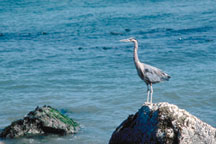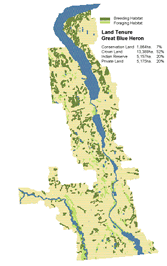|
Habitat Atlas for Wildlife at Risk
Great Blue Heron
Ardea herodias herodias

Great
Blue Heron
|

- Body length: 1 metre; wingspan: 1.8 metres.
- Tall, wading bird with long yellow legs and long
neck.
- Blue-grey body feathers, white head with a black
stripe above each eye and long, yellow bill.
- Adults have a white forehead and black head plumes.
- Distinguished in flight from cranes (which are
seen only in migration in the Okanagan): herons will
usually
curl their neck back against their body while cranes
hold their neck straight out.
Status:
British Columbia Blue List
Special Significance
In British Columbia, most of the human population lives
in the Great Blue Heron's natural habitat - the coast
and the Southern Interior. Continuing development
has destroyed valuable nesting and foraging areas.
To ensure the survival of these birds, efforts should
be made to protect natural habitat within 300 metres
of nesting colonies. The preservation of forests
near water will provide future nest sites. Herons,
their nests and eggs are protected under the British
Columbia Wildlife Act.
Distribution
- Found throughout southern Canada.
- British Columbia population found along the coast and
in the Southern Interior.
- No major nesting colonies occur in the South Okanagan-Similkameen.
- Some interior birds migrate to the coast for the
winter months.
Habitat
- Heron colonies are located in groves of large trees along the
banks of lakes, slow-moving rivers, sloughs, marshes and ponds in
the North
Okanagan.
- Grassy fields with abundant rodent populations may
be important habitat for winter survival.
Reproduction
- Herons nest in colonies, or heronries; most colonies are occupied
for years.
- Stick nests are lined with twigs, rushes, bark and
evergreen boughs; nest size is about 1 metre in
diameter.
- Nests are generally located in trees, 20-50 metres
above the ground.
- Pair bonding occurs from mid-February to early April.
- Three to five eggs are laid in April or May and hatch
in about 4 weeks.
- Mortality is high for birds in their first year.
- Oldest recorded age is 23 years.
Food Habits
- Herons patiently wade in calm, shallow waters for fish, frogs,
salamanders, snakes, large insects; also seen foraging in meadows
and fields for
mice and voles.
- They use their long, powerful neck and bill to grab
their prey.
Interesting Facts
- Heronries can occupy up to 2 hectares of forest containing over
400 nests. Okanagan colonies are much smaller, usually comprising
only
four or five pairs.
- Despite their tall stature, herons' average weight
is just over 2 kilograms.
- When herons catch rodents, they eat them whole. They
can digest the bones, but not the fur, which is spit
up in pellets.
Threats
- Human disturbance may cause abandonment of nest
colonies.
- Extensive land development has reduced the
availability of suitable nesting sites.
- Young have a low survival rate; an estimated
70 percent perish after they have reached
the flight stage.
Management Considerations
- Human activity should not occur within 300 metres
of active nest colonies.
- Disturbance of feeding areas such as marshes,
estuaries and fields should be avoided.
- Contact your local British Columbia Ministry
of Water, Land and Air Protection if a nesting
colony is located.
|
References
1. Campbell, R.W., N.K. Dawe, I. McTaggart-Cowan, J. Cooper, G. Kaiser
and M.C. McNall. 1990. Birds of British Columbia: Volume 1, Royal
British Columbia Museum, Victoria, BC.
2. Butler, R.W. 1995. Great Blue Heron, Ardea herodias.
The Birds of North America, No. 25. The American Ornithologists' Union.
eds. A. Poole, P. Stettenheim and F. Gill. The Academy of Natural
Sciences of Philadelphia, Washington, DC.
3. Butler, R.W. 1997. The Great Blue Heron. UBC Press.
|